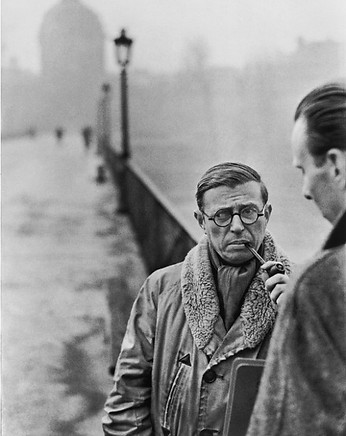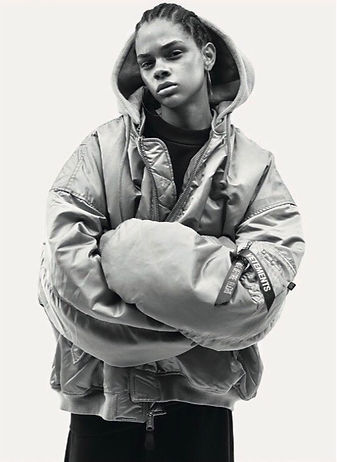
AMBIENT DESIGN
“The world is full of abandoned meanings. In them I often find unexpected themes and intensities.”
Don Delillo penned these words in 1985, inside his genius novel White Noise. Specifically, this phrase refers to the absurdity in excess that accompanies having to walk through aisles of products in a supermarket.
Fast forward to 2017, and in many ways the conditions of the supermarket can find their analog in the landscape of fashion. Just like the shelves of Delillo’s supermarket, the garments we are inundated with are full of unexpected themes, abandoned meanings, and surprising intensities.

The same capitalist system and its commercial realities are at the heart of both consumer goods and fashion. However, the difference between the supermarket Delillo describes and the fashion industry is that the former is full of a bland excess of consumer goods, while the latter reveals a diverse selection of intelligent and original design. Within these shared hyperactive conditions of production, creative expression has flourished.
Baseball shirts, basketball jerseys, coaches’ jackets, boxing shorts, and polo shirts are just as common in everyday wear as blue jeans and sneakers. Creative iterations of sportswear are made by nearly everyone in fashion, from the atelier of Margiela to corporate offices of Forever 21.
How did we get to this point? The history of turn towards sportswear is rich and of great depth, with unexpected resonances and meanings. Sportswear’s rise to a trope of the industry can tell us much about how designers finds inspiration, as well as how they reflexively inform and draw from culture at large.

A striking example of how sportswear can be repurposed outside of its narrow utilitarian purpose is the now infamous photo of Tupac Shakur spitting at the paparazzi outside a Manhattan courtroom, on July 4th 1994. Like any great photograph, this one captures true humanity; it connects in a profound way to the universal.
Tupac’s undeniable rage, combined with a sense of exhaustion and world-weariness, jump from inside the frame into the psyche of the viewer. Such a raw display of the chaos of the human spirit is deeply moving both on aesthetic and emotional planes.

Perhaps most importantly, the photo is undeniably attractive and visually striking; the simplicity of the Red Wings logo and the stark blocks of red and white contrast brilliantly with the rest of the frame. The artificial and aggressive shade of red conjures up the same rage that Tupac’s expression begets. The lively, bright and almost joyous red contradicts the bleak, piercing and violent action within the shot. Just as the color red is alone in the frame, Tupac is alone in the world.
This photo is doubtless an aesthetically appealing one. Despite its serious context and emotionality, it’s highly stylized. Tupac wears the Wings jersey in an interesting way; the proportions of his jersey are just as alluring as the jewelry it's styled with. The oversized, baggy garment acts as a shield for Tupac, revealing less of his body to the world than something more traditional. He can hide within a garment meant to contain shoulder pads and a chest protector, one designed to protect the skater from the violence of his sport.




It has never been established why Tupac was wearing this particular jersey, especially on the occasion of his sexual assault trail. He’s not from Detroit, nor did he ever have any reported affinity for the city. One would imagine that his interest in supporting a niche team in a niche sport, in an east-coast automobile production town was probably minimal. Maybe he was drawn to the aggressive nature of the sport itself, the only professional sport to sanction and in fact encourage fists as a means to settling disputes.
Tupac injected his own meaning into a Detroit Red Wings jersey. Tupac was young, brash, and a leading figure in popular culture, and he didn’t need garments made by fashion houses to complete an iconic look of defiance. He had faith in his own taste. Long before celebrities wore high-fashion hockey jerseys to appearances on talk shows, and 90’s gangster rap became the new elevator music of yuppie bars from coast to coast, this photo and the hockey jersey in it came to represent the one man’s frustration at the world, and the frustration of a generation.

It is images like that one and the ideas they communicate that inspire designers. This combination of aesthetic appeal and though-provoking concept reach a nexus in Tupac’s jersey. Sportswear acts as a conduit of new and interesting ideas for designers, expressed through design.
Sportswear can be at once both aesthetically interesting and representative of feelings and ideology; to create a dichotomy between the two is wrong. Sportswear’s functionality can serve as a point of reference for the fashion designer, just as the emotional aspects related to sportswear like achievement, endurance, and focus can.
Vacant and abandoned of rigorous conceptual meaning, sportswear is fertile ground for designers to inject and intertwine various inspirations. The pre-existing familiarity and cultural cache of sportswear intersect with more nuanced and complex references, and the result is often conceptually intriguing design and concept.
There is enough depth of inspiration and expansive areas of exploration within the realm sportswear that it has become the dominant trend of our age. It has become a trope that designers work within. Like any trope, as it becomes more common and even overused, it becomes harder to concretely define. In many ways, sportswear and its appropriation in fashion represent incompleteness in form, a rejection of totalizing, pure wholeness and meaning – much like fashion as a medium itself. Creative iterations of sportswear are often greater than the sum of their parts.
As Tupac did in 94’, the disillusioned masses of our era have chosen to wear sportswear as their uniform. Akin to the way that punks re-appropriated leather jackets, and the postmodern intellectuals wore the MA-1, at the core of every contemporary youth culture trend that inspired designers is sportswear. Leather lent itself well to the punks, it was resilient, tough, and abrasive – and even gaudy at times. Punks identified with the Hells Angels and Biker gangs on a spiritual level and expressed this with sartorial metaphor.


The MA-1 carried the baggage of the very military industrial complex and system of colonial oppression that the intellectuals sought to create an alternative to. These intellectuals were militant in thought, and sometimes in practice, and MA-1 was their sartorial symbol of choice.
Contrast these appropriations to the rebels of today that have chosen the banal universal appeal of sportswear as their uniform. Finding a single, unifying thread as to how and why this happened is impossible. Perhaps, just like Tupac, they are angry at the world and reject the meaning and choices forced upon them by the world they live in. They push back against handed down designations and boredom by crafting their own meaning in the simplicity of sportswear.

This push back against the system comes in unexpected ways, and sportswear is full of many intensities that go beyond its original purpose. One of the great benefits of rebellion against the status quo is the incredible creativity and alternative systems that emerge from it; the fashion and design worlds are no exceptions to this.
Fashion does not exist in a vacuum; it is an instant language that utilizes the power of context and timing to generate new cultural and commercial values. In 2017, sportswear and its expansive meaning and mysterious origins are the dominant languages of garment design. It is both a democratic and accessible sensibility. Perhaps Delillo was right when he wrote: “The Future belongs to crowds.”
text: Aaron Gray
Recommended For You

